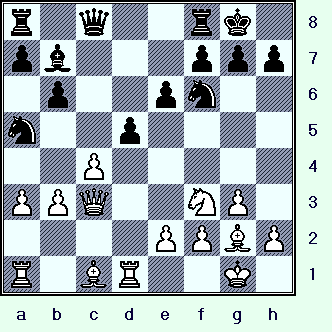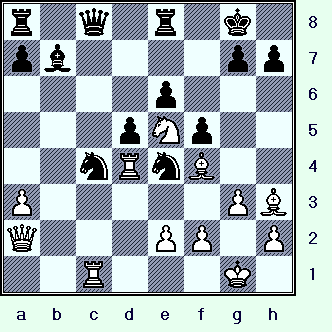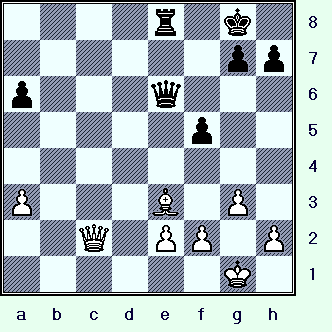ChessMaster 9000 (2600) - Fritz 8.0 (2600)
[E16]
Computer-vs.-Computer test, 10/11/2004.
This was a test that my
room-mate
and I did. We were curious to see which program was stronger. Both computers were set for a time limit of
45 moves in 90 minutes with an increment of 15 seconds per move. (The secondary time control was to be "Game - in One hour," but it never got that far.)
ChessMaster 9000 was run on my computer. (Generic PC, with an Intel, 3.4 GHz processor and 1.8 GB of RAM.)
Fritz 8.0 was run on my room-mate's PC, a DELL w/2.5 GHz processor and 512 MB of RAM.)
******************************************************************
The ratings are only approximations.
Each box was set to play the best
chess possible, with optimum settings and personalities.
The game starts of as a Reti.
1.Nf3 Nf6;
2.c4 e6;
3.d4 b6; {Diagram?}
We have transposed into a Queen's Indian Defense.
4.g3 Bb7;
5.Bg2 Bb4+!?;
A slightly unusual move, but there is nothing really wrong with it.
Now the game might be an unusual hybrid between the Queen's Indian Defense, A Nimzo-Indian, and even a "Bogo-Indian" Variation as well.
[
The main line probably begins with the move:
5...Be7!?; {Diagram?}
and according to a statistical breakdown of the database, is played
more than any other variation in this opening.
[ See MCO-14, page # 566; columns # 19 through # 24,
and all applicable notes. ]
]
Play proceeds down a path that I am not really familiar with.
6.Nc3 c5!?;
7.0-0 cxd4;
8.Qxd4 Nc6; 9.Qd3 0-0;
Apparently this is still 'book' ... albeit not one of the most heavily played main lines.
(There are less than 50 games in the database with this position.)
See the contest:
GM Boris Gulko - GM Yasser Seirawan;
National Championship Tournament
(semi-final) /
Salt Lake City, Utah/USA; 1999. {A game that was quickly drawn.}
10.a3!?,
(hmmm)
{Diagram?}
A seemingly tough decision, White gains the Bishop pair after this move ...
but allows Black play.
This may be the key move of the whole game. From this point on, White's game steadily deteriorates, with no appreciable errors on CM9000's part.
[ Gulko preferred to play:
10.Bd2, "+/=" ]
10...Bxc3!;
(hmmm)
Apparently Fritz does not wish to lose time by retreating the piece in this position.
[ After the moves:
(</=) 10...Be7!?; 11.Bf4,
"+/=" {Diag?}
White might be solidly better.
]
11.Qxc3 d5!;
(center!)
My first reaction was that this was premature, if a lower-rated player had played this I might have said that he did not understand the position we now have. (Black is allowing the game to open for White's Bishop pair.)
However, Black gets a ton of play and the results verify the program's decision to play this move.
[ I expected a move something like:
(</=) 11...Qe7!?; {Diag?}
followed by bringing the Rooks to the center of the board.
]
12.Rd1 Na5!?;
13.b3!? Qc8!; {See the diagram,
just below.}
Now Black is free of the pin on the d-file, has created a pin of his own on the c-file. Further, Black has no visible weak points, good play, and pressure against White's c4-square.
("Suddenly ... Black's game works!")
*********************
*********************
White's next move looks to be rather odd and un-natural.
{A dubious computer move? While this might be true, it is an extremely difficult
proposition in trying to find any improvements here for White.}
14.Rd4!? Re8!;
15.Bf4!? Ne4!; 16.Qc2 f6; 17.Bh3 b5!;
"=/+"
The initiative is firmly in Black's hands, most programs agree that Black is already better here.
18.Rc1!?,
While this might not look so great ... the first program already has severe difficulties here.
[ The other main try was Bd2 here for White.
But after the moves:
18.Bd2!? Nxd2; 19.Nxd2 dxc4;
20.bxc4 Qc6;
"=/+" (Maybe - '/+') {Diagram?}
Black is {also} clearly on top.
]
18...bxc4;
19.bxc4 Nxc4; 20.Qa2, {Maybe box?}
White's position us unenviable.
(To be honest, I thought White was dead lost here.)
[ Also possible was:
20.Qb3!?
]
20...f5;
21.Ne5!?, (hmmm)
{See the diagram ... just below here.}
Seemingly a natural move here.
*********************
*********************
One look at this position should tell you that White is in deep kim-chi.
[ Maybe
21.Qa1!?, here instead? ]
Now the move of ...Qc5; looked natural for Black in this position.
21...Ba6!?;
22.Nxc4 Bxc4; 23.Rdxc4!?, ('?!' / '?' or '!!')
I guess CM9000 prefers active defense to quiet desperation.
[ After the moves:
23.Qa1 Qa6; 24.Bg2 Rac8; "/+" {Diag?}
Black is clearly much better.
]
Now the fur flies, and the box finds a way to regain some of the material it has lost.
23...dxc4;
24.Rxc4 Qd7; 25.Bxf5! exf5!?; (Maybe - '!')
This is probably forced or best.
Of course it looks suicidal to allow a discovered check, but the box can accurately calculate all the squares and realizes that White has no real threats.
[ Instead, after the moves:
(</=)
25...Nf6!?; ('?!')
26.Bd3,
"~" {D?}
White has a solid position and some play for the lost material.
{Compensation?} ]
The next few moves appear to be pretty much forced.
26.Rxe4+ Qf7;
27.Rxe8+ Rxe8;
28.Qc2 Qe6; 29.Be3 a6; "/+" {D?}
Here the game was adjourned, (my room-mate wanted to go out for lunch); and this
position was now considered to be basically a win ("-/+")
for Black.
*********************
*********************
With best play, I think that Black will win, but this is not 100% certain.
(Computers do not always have perfect technique, especially in some very tricky endgames.)
An interesting game with some very unusual tactics. The main question for me is: "Can humans learn anything of real value from studying such a contest?"
Only time will tell.
*******
Copyright (c) A.J. Goldsby, 2004. All rights
reserved.
0 - 1
|


